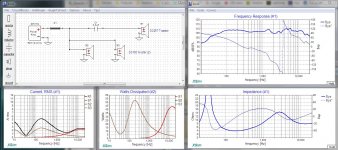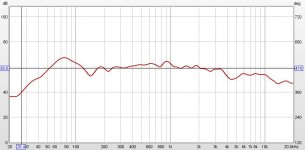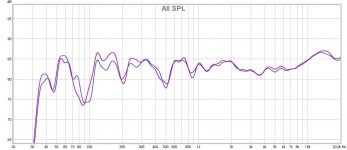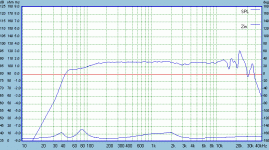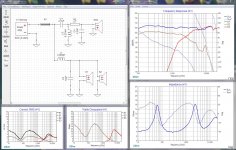I'm attaching some spec sheets you can look at...
The DC25T, also a hard dome, is a reasonable candidate.
The ND28f, a soft dome, is the one I used.
You could also consider an Air Motion tweeter.
As long as they can keep up with the woofers. That is, so long as we can adjust for a reasonably flat frequency response, you should be fine.
I know you're not a deeply technical guy, but these are your decisions...
I don't like the way that DQ25 is all over the place at higher frequencies.
Soft domes usually sound less harsh. Hard domes generally sound a bit brighter.
It's a question of what you want...
Sometimes you get real lucky and you can get what I have in the thumbnail below ... That's a Dayton T652 tower --2 X 6.5" + 1" hard dome-- with some tweaking. I added polyfill, changed the connectors to banana plugs and rewired them with 16ga wire, then changed the cap. The second thumbnail shows a REW scan of them in my room. But it's not quite that simple in your case, because your woofers have this massive spike of cone breakup at about 6khz that has to be accounted for.
When looking through the various tweeters available, look for sensitivity as high or higher than your woofers, power handling should be half or more of your woofers... But mostly look for smooth frequency response. We can adjust the crossovers for the rest.
The DC25T, also a hard dome, is a reasonable candidate.
The ND28f, a soft dome, is the one I used.
You could also consider an Air Motion tweeter.
As long as they can keep up with the woofers. That is, so long as we can adjust for a reasonably flat frequency response, you should be fine.
I know you're not a deeply technical guy, but these are your decisions...
I don't like the way that DQ25 is all over the place at higher frequencies.
Soft domes usually sound less harsh. Hard domes generally sound a bit brighter.
It's a question of what you want...
Sometimes you get real lucky and you can get what I have in the thumbnail below ... That's a Dayton T652 tower --2 X 6.5" + 1" hard dome-- with some tweaking. I added polyfill, changed the connectors to banana plugs and rewired them with 16ga wire, then changed the cap. The second thumbnail shows a REW scan of them in my room. But it's not quite that simple in your case, because your woofers have this massive spike of cone breakup at about 6khz that has to be accounted for.
When looking through the various tweeters available, look for sensitivity as high or higher than your woofers, power handling should be half or more of your woofers... But mostly look for smooth frequency response. We can adjust the crossovers for the rest.
Attachments
Last edited:
Here is what I get currently at 1M, smoothing 1/6 applied, on axis straight at tweeter. This is where my speakers are placed in the room, so yes, there is some reflection from things around them!
And also to mention, I saw Michael Chua paired the ZA5 with a Vifa XT25, and I have seen amazing reviews about the XT25.
Zaph ZA14 with XT25
I am actually very confused with all the options that are likely possible.
I am not sure how to go on deciding which tweeter I need, but I know that I hear my friend's B&W CM9 and I LOVE their sound, everything sounds perfect! And I just read that they have a metal dome tweeter. Is that something to take into consideration when deciding the type of tweeter?
And also to mention, I saw Michael Chua paired the ZA5 with a Vifa XT25, and I have seen amazing reviews about the XT25.
Zaph ZA14 with XT25
I am actually very confused with all the options that are likely possible.
I am not sure how to go on deciding which tweeter I need, but I know that I hear my friend's B&W CM9 and I LOVE their sound, everything sounds perfect! And I just read that they have a metal dome tweeter. Is that something to take into consideration when deciding the type of tweeter?
Attachments
Here is what I get currently at 1M, smoothing 1/6 applied, on axis straight at tweeter. This is where my speakers are placed in the room, so yes, there is some reflection from things around them!
If you use the "Psyacoustic" smoothing the curves will be much closer to what you actually hear. But it does look like you have a hot tweeter there...
I am actually very confused with all the options that are likely possible.
Take a deep breath ... nobody is going to let you make a huge mistake.
Look for a smooth response curve, comparable sensitivity and power handling. It's not that hard.
I am not sure how to go on deciding which tweeter I need, but I know that I hear my friend's B&W CM9 and I LOVE their sound, everything sounds perfect! And I just read that they have a metal dome tweeter. Is that something to take into consideration when deciding the type of tweeter?
That's kind of an apples and oranges comparison. The B&W is a three way system with twin 6.5" woofers... Yours is two way with dual 5.25" woofers. His system will just naturally move more air than yours.
If you use the "Psyacoustic" smoothing the curves will be much closer to what you actually hear. But it does look like you have a hot tweeter there...
Take a deep breath ... nobody is going to let you make a huge mistake.
Look for a smooth response curve, comparable sensitivity and power handling. It's not that hard.
That's kind of an apples and oranges comparison. The B&W is a three way system with twin 6.5" woofers... Yours is two way with dual 5.25" woofers. His system will just naturally move more air than yours.
I understand moving more air would mean that they offer better/perhaps lower bass. correct?
That's not the only thing I am talking about, the difference is HUGE between his speakers and mine. It's hard to describe the differences, but separation is amazing, vocals are WAY more pronounced and clear than my speakers, my speakers vocals sounds buried under the music for some reason, i have to listen hard for the lyrics to be understood....i hope its making some sense?
His amp is a Rotel stereo amp, 150w/ channel, maybe that makes a difference too, and we have never compared them in the same room with the same amp, I do understand the impact of speakers sounding different in different rooms.
Interesting thread.
I always try to make a Xover as simple as possible.
You talk about vocals being not so pronounced on yours, well that is not necessarily bad. On my own design the mid and top make them stand out, but on an expensive speaker I am using now they are as you describe, but not always.
The variation in vocal quality may be much higher on a better speaker, and that is what I am finding. (Assuming all those PhDs, team, facilities, money, and equipment were not a blag or waste of time and effort.)
I always try to make a Xover as simple as possible.
You talk about vocals being not so pronounced on yours, well that is not necessarily bad. On my own design the mid and top make them stand out, but on an expensive speaker I am using now they are as you describe, but not always.
The variation in vocal quality may be much higher on a better speaker, and that is what I am finding. (Assuming all those PhDs, team, facilities, money, and equipment were not a blag or waste of time and effort.)
I understand moving more air would mean that they offer better/perhaps lower bass. correct?
Mids and tweeters move air too. It's more about efficiency than anything else, the bigger woofers, midrange speaker and larger tweeter are going to do a better job.
It is ... Look at your REW scan, you have too much tweeter and too much bass going on. In the voice range (200 to 2khz) your speakers look a bit weak. Now part of that could be placement, part could be room... but I can see from the plot why you would think vocals are recessive.That's not the only thing I am talking about, the difference is HUGE between his speakers and mine. It's hard to describe the differences, but separation is amazing, vocals are WAY more pronounced and clear than my speakers, my speakers vocals sounds buried under the music for some reason, i have to listen hard for the lyrics to be understood....i hope its making some sense?
Let me tamper with the crossover a bit, using your existing drivers and see what I can come up with...
Mids and tweeters move air too. It's more about efficiency than anything else, the bigger woofers, midrange speaker and larger tweeter are going to do a better job.
It is ... Look at your REW scan, you have too much tweeter and too much bass going on. In the voice range (200 to 2khz) your speakers look a bit weak. Now part of that could be placement, part could be room... but I can see from the plot why you would think vocals are recessive.
Let me tamper with the crossover a bit, using your existing drivers and see what I can come up with...
Is it possible that it's totally my placement and room only?
Because looking at Zaph's own Frequency graph for my speakers which i have attached, i don't think the 200-2k range is recessed, what do you think?
Attachments
Ok, here's another way to do this. This time using all your current drivers and flat out replacing the crossovers to build a 2 way system.
I've used Alan's latest tweeter files.
Note that the frequency response is within +-3db right across the range. The box might affect it a bit but I think not enough to invalidate the design.
Frankly, given the relative expense of a few coils and caps, compared to new drivers, I'd be prone to try this design first...
I've used Alan's latest tweeter files.
Note that the frequency response is within +-3db right across the range. The box might affect it a bit but I think not enough to invalidate the design.
Frankly, given the relative expense of a few coils and caps, compared to new drivers, I'd be prone to try this design first...
Attachments
Last edited:
Is it possible that it's totally my placement and room only?
That is entirely possible... but... you still have red hot tweeters in that top octave. There isn't much musical energy up there and we're not used to hearing it as a distinct sound, so that could be very irritating and it could be masking the midrange, somewhat.
Remember the original XSim of that crossover? It wasn't pretty.
But hey, go for it... Moving the speakers around and running REW sweeps, is free.
Last edited:
That is entirely possible... but... you still have red hot tweeters in that top octave. There isn't much musical energy up there and we're not used to hearing it as a distinct sound, so that could be very irritating and it could be masking the midrange, somewhat.
Remember the original XSim of that crossover? It wasn't pretty.
But hey, go for it... Moving the speakers around and running REW sweeps, is free.
That could be very much be an issue, it does make sense to me!
I will try to use the Denon EQ I have on my AVR, which has these values.
63 Hz / 125 Hz / 250 Hz / 500 Hz / 1 kHz / 2 kHz / 4 kHz / 8 kHz / 16 kHz
Right now its all flat, any idea which frequencies I should play with to understand the effect? From my understanding, I should bring down the 16khz down like 5-6 dbs? and perhaps raise everything from 125-till 2khz by 3db?
The Denon should have an auto-correct function in it. Just set the test mic in your sweet spot and let it run.
That said... You really don't want to play with that while seeking the best speaker positions. You want your amps running flat. Move the speakers about an inch at a time... run a REW sweep, see what changes, then when you find the right direction, keep watching for when you go past it... be methodical, random doesn't work here.
Once you've found the right spot, do some measuring so you can put them back there if you ever need to move them for cleaning, etc.
Then, once you have them in their best spots, do two things ... first measure that they are equadistant from your sitting position and then measure they are at equal angles to your sitting position. If you can't achieve this, move your chair...
Then, finally let the Denon's auto correct run.
That said... You really don't want to play with that while seeking the best speaker positions. You want your amps running flat. Move the speakers about an inch at a time... run a REW sweep, see what changes, then when you find the right direction, keep watching for when you go past it... be methodical, random doesn't work here.
Once you've found the right spot, do some measuring so you can put them back there if you ever need to move them for cleaning, etc.
Then, once you have them in their best spots, do two things ... first measure that they are equadistant from your sitting position and then measure they are at equal angles to your sitting position. If you can't achieve this, move your chair...
Then, finally let the Denon's auto correct run.
Okay that is some amazing guidelines for me to follow for next time, but for now...
Woah...I didn't move anything around, i just dropped the 16khz frequency down about 6db, and 1db drop on the 8k. And the vocals weren't congested anymore! I think you are right about the tweeter running way too hot covering the midrange possibly! Plus the fact my music type might be way too different for my speaker's design as I mostly listen to rock/hiphop/house electronic music.
But it did make a big difference!
I will follow your guidelines Douglas and keep going at it!
Now I have hope of fixing my speakers through crossover tweaks or a tweeter swap!
EDIT: Forgot to mention, I always run my amp's room correction, and it sounds TERRIBLE! I have even measured it on REW, it even measures way terrible! The Auddyssey that is praised is the newer XT32 version, mine is the simple XT, which is not that appreciated but for some setting levels/distances!
EDIT 2: In abit I am going to pull out my measuring gear.
Any advice on measurements with regards to smoothing/gating? And also, should I keep my speakers in their current placement? or should I move them to the middle of the room? I ask this because I will be making measurements in my listening position aswell..as mentioned under.
I am thinking of making measurements at 1 meter, tweeter axis, WITHOUT the new EQ, WITH the new EQ, and then with Audyssey auto correction.
Then I will make the same three measurements at my listening position.
Woah...I didn't move anything around, i just dropped the 16khz frequency down about 6db, and 1db drop on the 8k. And the vocals weren't congested anymore! I think you are right about the tweeter running way too hot covering the midrange possibly! Plus the fact my music type might be way too different for my speaker's design as I mostly listen to rock/hiphop/house electronic music.
But it did make a big difference!
I will follow your guidelines Douglas and keep going at it!
Now I have hope of fixing my speakers through crossover tweaks or a tweeter swap!
EDIT: Forgot to mention, I always run my amp's room correction, and it sounds TERRIBLE! I have even measured it on REW, it even measures way terrible! The Auddyssey that is praised is the newer XT32 version, mine is the simple XT, which is not that appreciated but for some setting levels/distances!
EDIT 2: In abit I am going to pull out my measuring gear.
Any advice on measurements with regards to smoothing/gating? And also, should I keep my speakers in their current placement? or should I move them to the middle of the room? I ask this because I will be making measurements in my listening position aswell..as mentioned under.
I am thinking of making measurements at 1 meter, tweeter axis, WITHOUT the new EQ, WITH the new EQ, and then with Audyssey auto correction.
Then I will make the same three measurements at my listening position.
Last edited:
I am thinking of making measurements at 1 meter, tweeter axis, WITHOUT the new EQ, WITH the new EQ, and then with Audyssey auto correction.
Then I will make the same three measurements at my listening position.
Leave your speakers in place ... if you are measuring the speakers themselves, set up about 1m away, on axis, with the mic centered between the upper woofer and tweeter. REW has a gated measurement in the RTA panel where you can narrow the "window" to exclude most room effects. But for most general purpose measurements the standard scan with "Psyacoustic" smoothing is just fine.
If you are measuring the room, put your mic in your sweet spot, with your speakers in place. Moving the speakers in this case totally defeats the idea of trying to chart what you are hearing.
For the difference you noticed ... Masking is not an uncommon phenomenon. Your ears tend to auto-adjust to the loudest sounds. When the sound balance is off, so is your hearing. Loud shrill sounds cover soft sounds... your midrange disappears. More than a few times I've given people "more bass" simply by putting a resistor in series with their tweeters...
Last edited:
Okay so I just did some testing.
Here is the song I used. If someone else can play this on their system, and comment back, it would really help!
YouTube
The Weeknd - Alone Again
And this too.
YouTube
The Weeknd - After Hours
I don't listen to The Weeknd , and its not an issue if my speakers can't play these right. The thing is, this will probably help everyone understand my issue. Since my other music that I listen to, is probably more similar than not.
I just tested this on my speakers, even with the 16khz db'd down about 5b lower, I still couldn't manage to understand the first few lines at ALL.
Then I played this just now on my average budget cheap headphones of around 50 USD, and I can understand each and everything.
EDIT : Perfect Douglas, thankyou once again! So measuring is to be done between the tweeter and the woofer, not pointed exactly at the tweeter? I always measure pointed directly at the tweeter. I will keep this in mind and make my measurements!
Here is the song I used. If someone else can play this on their system, and comment back, it would really help!
YouTube
The Weeknd - Alone Again
And this too.
YouTube
The Weeknd - After Hours
I don't listen to The Weeknd , and its not an issue if my speakers can't play these right. The thing is, this will probably help everyone understand my issue. Since my other music that I listen to, is probably more similar than not.
I just tested this on my speakers, even with the 16khz db'd down about 5b lower, I still couldn't manage to understand the first few lines at ALL.
Then I played this just now on my average budget cheap headphones of around 50 USD, and I can understand each and everything.
EDIT : Perfect Douglas, thankyou once again! So measuring is to be done between the tweeter and the woofer, not pointed exactly at the tweeter? I always measure pointed directly at the tweeter. I will keep this in mind and make my measurements!
Last edited:
First you need to start with someone talking... general rule... get the voices right first.
Then you need a very clear and effortless singer with very simple instruments..
YouTube
Then finally an instrumental, listening for the clarity of basic instruments...
YouTube
Also make sure your choices aren't autotuned, compressed, quantized or synthetic... All these things reduce clarity. You want pure recordings of natural sounds, and that almost always sends you back to the 60s, 70s, or 80s for source material.
Last edited:
I understand what you are trying to say. As the music I have linked, probably has every single thing you mentioned it should not have...
I just want to know if everyone's system faces the same problem with the song that I have linked, or is it just me? Are you all able to understand everything?
EDIT : Vocals/Voices sound extremely clear if I am listening to someone just talking, lets say its someone reviewing a product or something and they're just talking, EXTREMELY clear.
I just want to know if everyone's system faces the same problem with the song that I have linked, or is it just me? Are you all able to understand everything?
EDIT : Vocals/Voices sound extremely clear if I am listening to someone just talking, lets say its someone reviewing a product or something and they're just talking, EXTREMELY clear.
Last edited:
I just want to know if everyone's system faces the same problem with the song that I have linked, or is it just me? Are you all able to understand everything?
Nope ... it's too compressed for that and a guy singing falsetto doesn't help.
EDIT : Vocals/Voices sound extremely clear if I am listening to someone just talking, lets say its someone reviewing a product or something and they're just talking, EXTREMELY clear.
That's a start.
How'd you make out with my choices?
Did you hear Melanie overload the mic?
While we're at it... here's one of my favorite "turn it up" test pieces...
YouTube ... listen for the rotating speakers, the rivets in the cymbols and the undistorted guitar. Back when that song was new, I got noise complaints from 2 blocks away.
Last edited:
Yep, that's Melanie ... but if you listen closely there are half a dozen spots where she gets loud enough to overload the mic... it sounds a bit like clipping, a rough edge on her voice. It only lasts a few seconds at a time, but it is there.
That's back when people still had talent
That's back when people still had talent
Last edited by a moderator:
- Status
- This old topic is closed. If you want to reopen this topic, contact a moderator using the "Report Post" button.
- Home
- Loudspeakers
- Multi-Way
- Working the crossover for better impedance
